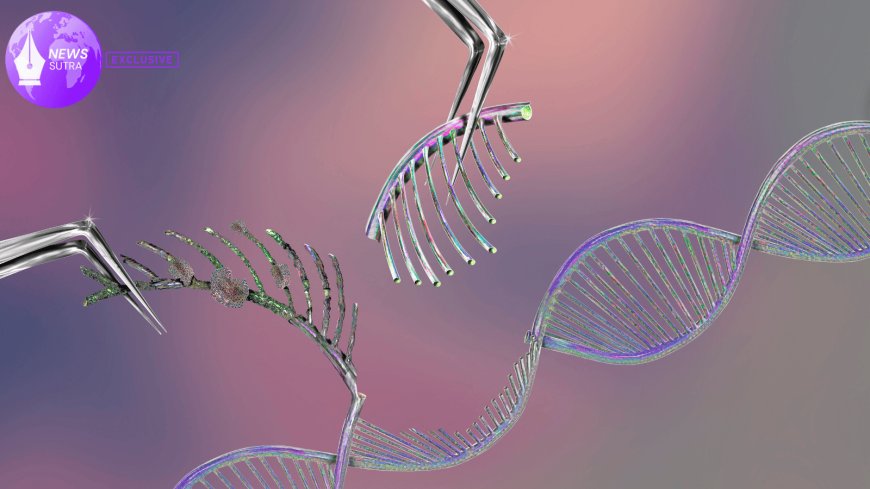The Weird World of CRISPR Gene Editing: Rewriting DNA, Curing Diseases, and Wrestling with Ethics in 2025
Explore the fascinating world of CRISPR gene editing in 2025—how it cures genetic diseases, reshapes agriculture, and sparks ethical debates over designer babies and biohacking.

In just over a decade, CRISPR-Cas9 gene editing has gone from a scientific curiosity to one of the most disruptive technologies shaping medicine, agriculture, and even the future of humanity. What began as a discovery in bacterial immune systems is now at the heart of a global conversation that blends astonishing medical breakthroughs with unsettling ethical dilemmas.
As of 2025, CRISPR has moved from labs into real-world applications, treating diseases once thought incurable. But with this progress comes a question society cannot ignore: how far should we go in rewriting the very code of life?
Origins: From Bacterial Defense to Human Medicine
The CRISPR story started in the late 1980s when researchers noticed unusual repeating sequences in bacterial DNA. These turned out to be part of a natural immune defense system. Bacteria used CRISPR sequences and Cas proteins to identify and cut viral DNA, protecting themselves from infection.
It wasn’t until 2012 that Jennifer Doudna and Emmanuelle Charpentier published a landmark paper showing that this bacterial mechanism could be reprogrammed to edit DNA in other organisms with precision. This discovery would eventually earn them the Nobel Prize in Chemistry in 2020, and CRISPR quickly became the foundation of a revolution in genetic science.
CRISPR in Action: From Sickle Cell to Blindness
The medical world has seen an extraordinary leap forward thanks to CRISPR-based therapies. In 2024, the U.S. Food and Drug Administration approved Casgevy, a CRISPR therapy for sickle cell anemia and beta-thalassemia. Patients who once faced a lifetime of painful crises and shortened lifespans now have a shot at permanent cures.
Other breakthroughs are underway. Early-stage clinical trials are exploring CRISPR’s potential in treating inherited blindness, muscular dystrophy, and even certain cancers. Scientists are also looking at how CRISPR could be used against infectious diseases, such as engineering immune cells to fight HIV or COVID-19 variants more effectively.
For many patients, this is nothing short of a miracle: diseases rooted in genetics, once untouchable, are now on the frontline of medical innovation.
The Ethical Minefield: Designer Babies and Biohacking
With progress comes controversy. The moment gene editing entered the public eye, ethical debates erupted—none more intense than the idea of “designer babies.”
The infamous case of He Jiankui, the Chinese scientist who edited embryos in 2018, still casts a long shadow. While his work was widely condemned, the idea of editing embryos to prevent genetic diseases—or enhance physical and cognitive traits—remains both tempting and terrifying.
The debate is far from theoretical. In 2025, discussions on Capitol Hill, European parliaments, and international bioethics panels continue to wrestle with whether germline editing (changes passed on to future generations) should ever be allowed. Critics warn of a slippery slope toward eugenics, while supporters argue that preventing heritable diseases could be a moral obligation.
Adding to the complexity is the rise of biohackers—independent researchers and hobbyists experimenting with gene editing outside of traditional labs. While many claim to pursue DIY science for curiosity or personal health, others see it as a dangerous, unregulated frontier.
CRISPR and Agriculture: Feeding the Future
Beyond human health, CRISPR is rewriting agriculture. Scientists are engineering crops that resist drought, pests, and diseases, potentially transforming food security in an era of climate change.
For example, CRISPR-edited rice strains are already being tested to withstand floods, and new varieties of wheat may soon resist devastating fungi like wheat rust. Livestock research is also underway, with pigs and cows being edited for disease resistance and productivity.
Yet, here too, ethical and environmental debates loom. Critics question the unintended consequences of releasing genetically edited organisms into ecosystems, while advocates argue that CRISPR could prevent global hunger.
2025: A Turning Point for Humanity
As of this year, CRISPR feels less like a future concept and more like a defining feature of our time. Conferences such as the International Summit on Human Genome Editing continue to attract heated debates, while scientific journals fill with breakthroughs that push the boundaries of what is possible.
The technology’s dual identity—as both a beacon of hope and a Pandora’s box—keeps it at the center of global discussions. On platforms like Reddit’s r/science, CRISPR-related posts often attract thousands of comments, reflecting both the excitement and unease it stirs in the public imagination.
The Road Ahead
So, where do we go from here?
-
Medical Expansion: Expect more CRISPR therapies to win regulatory approval in the next few years, with cancer immunotherapies high on the list.
-
Global Regulation: Nations will need to align on ethical standards to avoid a genetic “Wild West.”
-
Public Dialogue: The debate must extend beyond labs and legislatures, ensuring communities and patients shape the future of gene editing.
Ultimately, CRISPR is not just a tool—it’s a mirror. It reflects our hopes for curing disease, our fears of unintended consequences, and our responsibility to handle life’s most fundamental code with humility.
Conclusion
The weird world of CRISPR in 2025 is equal parts thrilling and unnerving. It is already rewriting medical history, but it also forces humanity to confront some of its deepest ethical questions. How we handle this technology will shape not only the future of science but the very definition of what it means to be human.
As the pace of discovery accelerates, one thing is certain: the CRISPR conversation is just beginning.
What's Your Reaction?
 Like
0
Like
0
 Dislike
0
Dislike
0
 Love
0
Love
0
 Funny
0
Funny
0
 Angry
0
Angry
0
 Sad
0
Sad
0
 Wow
0
Wow
0








































































